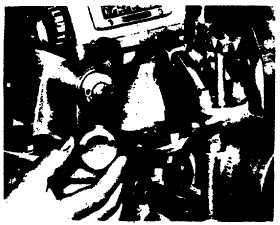|
| |
APPENDIX A
After adjustment is made and the access cover is
replaced it should be sealed to prevent unauthorized
persons from changing the final adjustment.
The
correction
impulse
causes
a
momentary
acceleration of the register which will result in errors and
erratic tests if not taken into account.
FIG. 18.
It is important when calibrating a meter that the volume
of the calibrated prover be a multiple of the increment of
correction of the meter. For example, a prover for
Model "S" Meters which are geared to calibrate in five
gallon increments should be 200, 205 or 210 gallon
capacity and not 203 or 207. For a Model W, D or M-60
which is normally geared to give a correction impulse for
each barrel it is essential that the prover be calibrated in
even 42 gallon barrels.
The reason for the above is evident as each test run
must contain the same number of correction impulses in
order to be absolutely accurate. If the test is started
with the meter register at zero, the register at the end of
the test run should show a quantity divisible by the
number of gallons or barrels delivered for each
revolution of the calibrator, or each correction impulse.
The magnitude of the meter correction is in the order of
4 or 5 per cent of the volume of meter thruput per
correction input cycle. On a standard "S" Meter this
would be 4 or 5 per cent of 5 gallons and on a barrel
geared meter it would amount to 4 or 5 per cent of 42
gallons. The type of register used is not necessarily an
indication of meter correction frequency, as a gallon
geared meter maybe equipped with a register geared to
read in barrels.
It is therefore desirable to have the prover tank of a
volume which conforms to even increments of full
barrels as well as increments of 5 gallons, as for
example, 30 barrels or 1260 gallons. A prover of this
size makes it possible to test either a gallon geared
meter or a barrel geared meter. By starting and
stopping the meter' on an even barrel or five gallon
increment as the case may be and reading the error on
the prover scale, the error due to meter correction
impulse is entirely eliminated.
Many meters with gallon gearing are equipped with
barrel registers and it may be necessary to test these
meters into a barrel calibrated prover. Further, the
prover may be of an odd size, barrels and fractions of
barrels.
Take as an example a prover of 29.3 barrel capacity
being used to test a meter with gallon gearing (5 gallons
per revolution ) with a register reading in barrels. The
register will be assembled with 8.4 - 1 gear ratio.
In a case of this kind the meter calibrator impulse error
can be avoided by the following procedure:
Determine the number of gallons contained in the prover
29.3 = 1230.6 gallons. Reduce this to the nearest
number divisible by 5 or 1230. Now consider the
volume of the prover 1230 gallons or 29.285 barrels
instead of 29.3 barrels. Make a test run stopping the
meter at exactly 29.285 barrels thereby completing the
full number of correction cycles. Read the error on the
prover scale.
Since it is not possible to stop the register exactly at
29.285 barrels, the next test run should be made to stop
the meter register at 58.570 barrels ( 29.285 plus 29.285
). Each successive test run should be made to stop the
meter register at 29.285 barrels added to the last
counter registration at which the meter register should
have been stopped. Do not add the 29.285 barrels to
the actual counter registration except on the first test
run. Do not reset the register for each test run
A9-30
|

